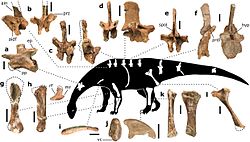Pulanesaura
| Pulanesaura | |
|---|---|

| |
| Skeletal restoration | |
| Scientific classification | |
| Domain: | Eukaryota |
| Kingdom: | Animalia |
| Phylum: | Chordata |
| Clade: | Dinosauria |
| Clade: | Saurischia |
| Clade: | †Sauropodomorpha |
| Clade: | †Anchisauria |
| Clade: | †Sauropoda |
| Genus: | †Pulanesaura McPhee et al., 2015 |
| Type species | |
| †Pulanesaura eocollum McPhee et al., 2015
| |
Pulanesaura is an
sauropod known from the Early Jurassic (late Hettangian to Sinemurian) Upper Elliot Formation of the Free State, South Africa. It contains a single species, Pulanesaura eocollum, known from partial remains of at least two subadult to adult individuals.[1]
Discovery and naming

The remains of Pulanesaura were discovered in a small quarry in the farm Spion Kop 932 in the
sauropod not yet showing the most archetypal trait of more advanced sauropods - their very long necks.[1] Pulanesaura was one of eighteen dinosaur taxa from 2015 to be described in open access or free-to-read journals.[2]
Pulanesaura is known from partial remains of at least two subadult to adult individuals. The
Arcusaurus pereirabdalorum.[1]
Phylogeny



Pulanesaura is a medium-sized
sister taxon to Sauropoda, depending on the definition for Sauropoda used (node or stem based). The following cladogram is simplified after this analysis (members of bold taxa are not shown).[1]
| Plateosauria |
| |||||||||||||||||||||
The following cladogram shows the position of Pulanesaura within Massopoda, according to Oliver W. M. Rauhut and colleagues, 2020:[3]
| Massopoda |
| ||||||||||||||||||
Paleoecology

Pulanesaura's posture and skeletal build indicate that the animal was a low browser, unlike the prosauropods it shared its habitat with. Studies by Blair McPhee et al. indicate that Pulanesaura is thought to have coexisted with other sauropodomorphs found in the same formation due to
niche partitioning. Its flexible neck would have further allowed it to feed without moving its body very often and expending valuable energy; a trait that later sauropods would take to extreme lengths. Studies of the Upper Elliot Formation suggest that the environment was a predominantly arid floodplain where vegetation was concentrated most heavily around the river channels that flowed through the area, further allowing the coexistence of Pulanesaura with other sauropodomorphs such as Aardonyx and Arcusaurus.[1]
References
- ^ PMID 26288028.
- ^ "The Open Access Dinosaurs of 2015". PLOS Paleo. Archived from the original on 2017-07-15. Retrieved 2016-01-30.
- S2CID 220294939.
Further reading
- Blair W. Mcphee & Jonah N Choiniere (2017). The osteology of Pulanesaura eocollum: implications for the inclusivity of Sauropoda (Dinosauria). Zoological Journal of the Linnean Society, zlx074 (advance online publication). doi: https://doi.org/10.1093/zoolinnean/zlx074 https://academic.oup.com/zoolinnean/article-abstract/doi/10.1093/zoolinnean/zlx074/4561573/The-osteology-of-Pulanesaura-eocollum-implications?redirectedFrom=fulltext
